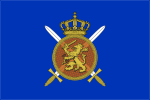Royal land power
|
Royal land power |
|
|---|---|
 Coat of arms of the Koninklijke Landmacht |
|
| Lineup | January 9, 1814 |
| Country |
|
| Armed forces | Dutch armed forces |
| Type | Armed forces ( army ) |
| structure | see subsection |
| Strength | 27,000 soldiers |
| headquarters | Kromhoutkazerne in Utrecht |
| equipment | see subsection |
| management | |
| commander | Lieutenant General Martin Wijnen |
| insignia | |
| Public relations logo |

|
| War flag |

|
The Koninklijke Landmacht (literally: Royal Army) is the armed land force of the Dutch armed forces .
General
With around 27,000 soldiers, the Royal Dutch Army is the largest part of the Dutch army . The army is in a process of transformation in order to adapt to the new security policy requirements. For this purpose, among other things, the mechanized Brigade 41 was relocated from Seedorf in Germany back to the Netherlands in 2005.
Most of the Leopard 2 main battle tanks (100 pieces) were sold to Finland. All that remains is a company with 18 vehicles, which is integrated into the German tank battalion 414. This is subordinate to the 43rd Gemechaniseerde Brigade .
structure
CLAS
The Dutch army is led by the Commando Landstrijdkrachten (CLAS), the Dutch military command. The command leads both combat units and regional support units. This includes:
Combat Brigades
- 11 Luchtmobiele Brigade (11th Air Mobile Brigade)
- 13th Light Brigade (13th Light Brigade)
- 43 Gemechaniseerde Brigade (43rd Mechanized Brigade)
Support units
The Land Operational Support Units ( Operationeel Ondersteuningscommando Land ) provides combat support and logistics for the brigades through telecommunications, electronic warfare , (artillery) reconnaissance, pioneers, logisticians, paramedics and NBC defense .
- Command & Control support command ( Command & Control Ondersteuningscommando ), in Stroe
- Reconnaissance Command ( Joint ISTAR Commando - JISTARC), in 't Harde
- Fire Support Command ( Vuursteun Commando ), in 't Harde
- 41st Artillery Division ( 41 Afdeling Artillery )
- 1st Civil-Military Cooperation Command ( 1 Civiel en Militair Interactiecommando ), in Apeldoorn
- Supply and Transport Command ( Bevoorrading en Transport Commando ), in Stroe
- 101 Engineer Battalion ( 101 Geniebataljon ), in Wezep
- 400 medical battalion ( 400 Geneeskundig bataljon ), in Ermelo
- Ordnance clearance service ( Explosieven Opruimingsdienst Defensie ), in Soesterberg
- Land Forces Command Support Group ( Ondersteuningsgroep CLAS ), in Arnhem
Special Forces Command
All special forces fall under the special forces command (Corps Commandotroepen). The command is structured as follows:
- Staff and supply company ( Stafverzorgings- en instructiecompagnie )
- Command Company 103 ( 103 Commandotroepencompagnie )
- Command Company 104 ( 104 Commandotroepencompagnie )
- Command Company 105 ( 105 Commandotroepencompagnie )
- Command Company 108 ( 108 Commandotroepencompagnie )
Cooperation with the Bundeswehr
Both the Dutch and the German armies participate in the 1st German-Dutch corps with one division each, if necessary . Its forerunners were the 1st Corps on the German side and the 1st Legerkorps on the Dutch side . A German and a Dutch general alternately take the lead.
On April 4, 2018, the German anti-aircraft missile group 61 in Todendorf (Panker) was placed under a Dutch command.
equipment
Light weapons
Pistols and submachine guns
Assault rifles
- Colt Canada C7NLD (Canadian version of the M16 )
- Colt Canada C8NLD (carbine)
- Heckler & Koch HK416
- Heckler & Koch HK417
Machine guns
Sniper rifles
- Steyr Mannlicher SSG 69
- Accuracy AWM
- Barrett M82A1
Shotguns
- Mossberg M590A1 Special Purpose
Grenade launchers and anti-tank weapons
- 40 mm grenade launcher
- HK GMW
- M72 LAW
- Spike (anti-tank weapon, medium range)
- Panzerfaust 3
Armored vehicles
- Reconnaissance vehicles
- 410 Fennec
- Main battle tank
- Armored personnel carriers
- 149 CV90 35NL + additional armor
- Armored transport
- 1275 Iveco Medium Tactical vehicle (on order)
- 104 Bushmaster
- 200 GTK boxers
- 515 Mercedes-Benz G300 CDI Air Assault (on order)
- 75 Defenture VECTOR
- Electronic warfare
- 12 fox
- Pioneer vehicles
- NBC defense
- 12 fox
artillery
- mortar
- 60 mm M6 mortar
- 81 mm mortar L16A2
- 120 mm tank mortar
- Self-propelled howitzers
Unarmored vehicles
- 5500 Mercedes-Benz G-Class (Wolf) ( various versions )
- 1527 Volkswagen Amarok
- 2400 DAF trucks ( various versions )
- 2037 Scania Gryphus ( various versions )
literature
- Sören Sünkler: Europe's elite and special units. Motorbuch Verlag, Stuttgart 2008, ISBN 3-613-02853-0 .
Web links
Individual evidence
- ↑ Carl Schulze / Frank Bötel: Ground-based air defense: From cooperation to integration. bundeswehr.de, April 5, 2018, accessed April 7, 2018 .
